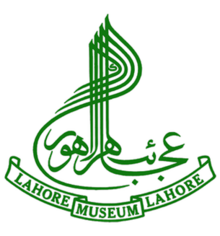لہور میوزیم عجائب گھر لاہور | |
 | |
 Entrance to the museum | |
Former name | Central Museum |
|---|---|
| Established | 1865, moved to present site in 1894 |
| Location | The Mall, Lahore, Punjab, Pakistan |
| Coordinates | 31°34′06″N 74°18′29″E / 31.568226°N 74.308174°E |
| Type | Archaeology, art, heritage, modern history, religious |
| Collection size | 58,000 |
| Visitors | 227,994 (2018) |
| Director | Sadia Tehreem |
| Curator | Naushaba Anjum |
| Owner | Ministry of Information & Broadcasting (National Heritage and Culture Division) |
| Public transit access | Civil Secretariat, Lahore Metrobus |
| Website | lahoremuseum |
The Lahore Museum (Punjabi: لہور میوزیم; Urdu: عجائب گھر لاہور; lit. 'Lahore Wonder House') is a museum located in Lahore, Punjab, Pakistan. Founded in 1865 at a smaller location and opened in 1894[1] at its current location on The Mall in Lahore during the British colonial period, Lahore Museum is Pakistan's largest museum, as well as one of its most visited ones.[2][3][4]
The museum houses an extensive collection of Buddhist art from the ancient Indo-Greek and Gandhara kingdoms. It also has collections from the Indus Valley Civilisation, Mughal Empire, Sikh Empire and the British Indian Empire.[5]
The Lahore Museum, along with the Zamzama Gun located directly in front of the building, is the setting of the opening scene in the novel Kim by Rudyard Kipling,[6][7] whose father, John Lockwood Kipling, was one of the museum's earliest curators.[8]
- ^ "Lahore Museum | museum, Lahore, Pakistan | Britannica". www.britannica.com. Retrieved 14 July 2022.
- ^ "Tourism boom: Foreigners visiting cultural sites, museums in Pakistan up by 121%". The Express Tribune. 30 September 2019. Retrieved 14 July 2022.
- ^ Akhtar, Anwar (7 July 2020). "Pakistan's Best Kept Secret: Lahore Museum". www.salzburgglobal.org. Retrieved 14 July 2022.
- ^ Tariq, Minahil (22 January 2017). "A historic neglect | Shehr | thenews.com.pk". The News International. Retrieved 14 July 2022.
- ^ "AROUND TOWN: Lahore Museum". Dawn. 31 October 2008. Retrieved 7 September 2021.
- ^ Kaplan, Robert D. (29 January 1989). "Lahore as Kipling Knew It". The New York Times. ISSN 0362-4331. Retrieved 14 July 2022.
- ^ Jordison, Sam (19 January 2016). "Rudyard Kipling's Kim: a zam-zammer wonder-house of wordplay". The Guardian. Retrieved 14 July 2022.
- ^ "V&A · Research project: John Lockwood Kipling". Victoria and Albert Museum. Retrieved 14 July 2022.
